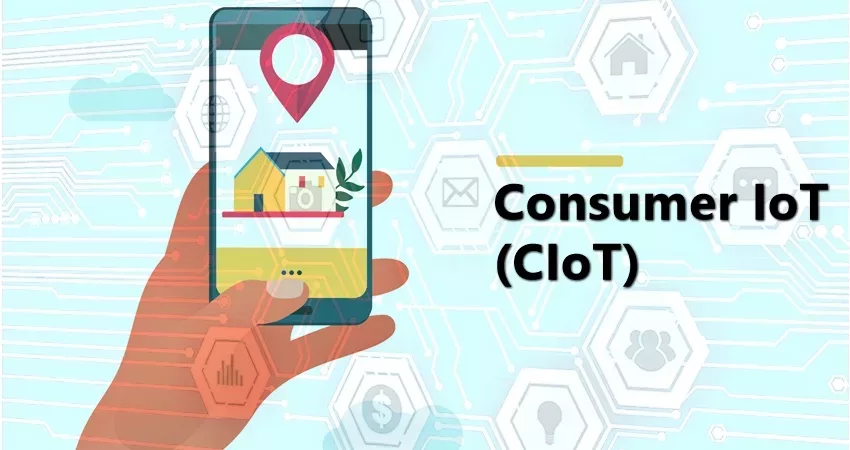Consumer IoT Devices and Applications
Market Size and Future Trends of Consumer IoT
Difference between Consumer IoT and Industrial IoT
Consumer Internet of Things or CIoT is an interconnected system of physical and digital objects, personally used by a consumer.
These interrelated devices are provided with unique identifiers (UIDs) to recognize and access various entities for many purposes.
Consumer IoT covers all the user’s network around their personal and home devices.
In IoT, the devices are integrated with multiple wireless technologies and microcontrollers. That makes it easier to share consumer data and information without any individual’s direct interaction with each other or the computer.
Consumer IoT devices and their applications are quickly integrating themselves into our daily routine.
Consumers benefit from IoT systems in a lot of ways. Consumer IoT applications are increasing in efficiency and ease of use with fast-growing computing capabilities.
Consumer IoT devices use edge computing technologies. It improves scalability and saves power in consumer IoT devices’ by crunching data instantaneously. It also enables and optimizes data visualization and M2M communications.
The Internet of Things devices covers the mechanical and digital systems that are interconnected and can collect and share data amongst each other with the help of sensors.
IoT Device employs built-in sensors, Bluetooth, RFID, NFC, GPS, and internet connectivity in your smartphones and other devices to capture accurate time and location.
However, this may also pose privacy and security threats in some cases.
You have IoT systems that help you manage all of your consumer IoT apps and devices easily.
For example, you have smartphones that can be used to access all the products around your smart home.
In short, everything is interlinked in IoT.
Consumer IoT devices and applications are mainly subdivided into two types:
Personal IoT
Personal IoT devices and applications include wearable, hearable, smartphones and personal laptop gadgets such as-
- Smart Clothing
Examples – Ralph Lauren smart t-shirt, Arrow Smart Shirt with NFC. - Smart Watch
Examples – Apple Watch, Fitbit. - Battery power-sharing between two smartphones
Examples – Donor Cable bracelets by NAR Mobile. - Hearable
Examples – AirPods, Google Pixel Buds. - Smart glass
Examples – Dropcam from Google, Vuzix Smart Glasses.
Smart Home IoT
Smart Home IoT devices and applications include home automation products like smart kitchen gadgets and security systems with face recognition and voice control. Some examples are as follows-
- Voice Assistance
Examples – Amazon Echo and Google Home Smart Voice-Activated Speaker - Security
Examples – Nortek Security & Control products for access control & emergency, Bitdefender BOX. - Lighting fixtures
Examples – Philips Hue Smart Bulbs, LIFX, L8 SmartLight, etc. - Smart Energy Savings
Examples – Ambi Climate, Neurio, iDevices Switch, Rachio Smart Sprinkler Controller, etc. - Family Entertainment
Examples – Keepon social robot, Kuri home robot, Singlecue gesture control. - Smart Kitchen Gadgets
Examples – iGrill Smart grill thermometer, Samsung Family Hub, Birdi monitors.
The above mentioned IoT products cover only some of the top numerous consumer IoT trends right now.
The ongoing competition is fierce, owing to the potential of IoT in the consumer market.
Multiple notable companies are participating and exploiting the trends in combination with technologies like big data, machine learning, 5G, deep learning cloud, and edge computing.
Consumer IoT trends are setting an example with every step because of their extensive usage and capabilities. This Consumer IoT market is spreading rapidly due to its following applications:
- Asset tracking
- Games and Entertainment
- Health monitoring
- Home security
- Parental tracking
- Quick Panic Buttons/SOS
According to the Global Consumer IoT Market report, Consumer IoT Market is estimated to reach USD 153.80 Billion by 2026. By 2023, home automation devices with smart energy management and security applications will hold the largest share of the consumer IoT market.
The growing use of the internet, smart devices adoption, and increasing security are the major driving factors for consumer IoT market growth.
Also Read: 8 Applications of Industrial Internet of Things
The Internet of Things as a whole has a comprehensive set of applications in multiple industries.
With the latest and emerging technologies, the Internet of Things is getting stronger and broader in terms of usage. Internet of Things devices and applications are mainly are divided into:
- Commercial IoT
- Consumer IoT
- Industrial IoT (IIoT)
- Infrastructure IoT
- Military Things (IoMT)
Consumer IoT vs. Industrial IoT
Consumer IoT (CIoT) provides convenience and a better lifestyle for individuals mostly. On the other hand, the Industrial IoT (IIoT) has been the focus of attention for the organizations.
Just like CIoT, IIoT has a variety of applications to help industries and factories upgrade and automate their machinery and other systems.
Some IIoT applications are manufacturing, energy management, and predictive maintenance. IIoT deals with much high powered systems and security issues.
Thus, to deal with it, the Industrial IoT systems need to have a higher tolerance and resilience for greater transparency, availability, scalability, and maintenance.
The internet of things is one of the digital pillars of every industry. IoT system usage is also the primary focus of the ongoing Fourth Industrial Revolution (4IR) or Industry 4.0.
The approval and consumption of IoT have only spiked up since the IoT term was first conceived in 1999.
Globally, the IoT is eminent amongst users due to its ease of convergence with multiple technologies and its real-time monitoring and feedback.
The IoT is an extensive system with a growing number of devices. And its applications and use cases will only see an outgrowth in terms of usage and popularity.
You May Also Like To Read-

